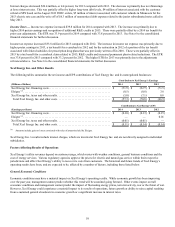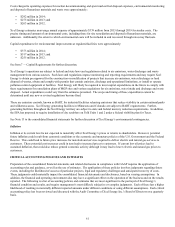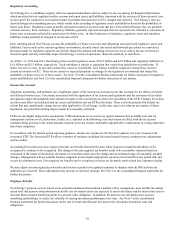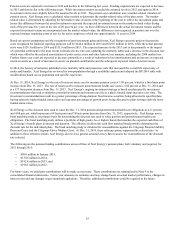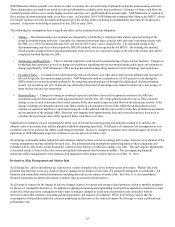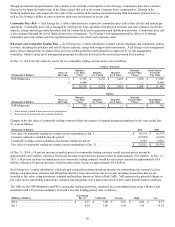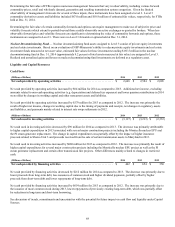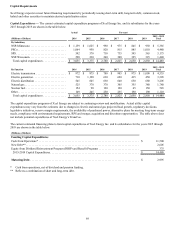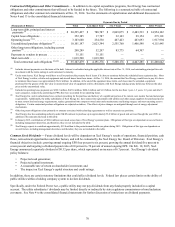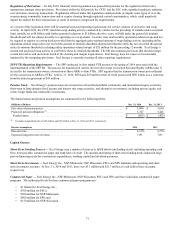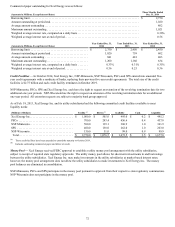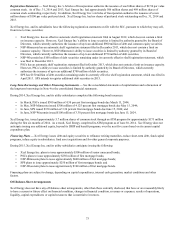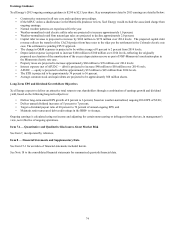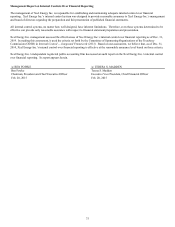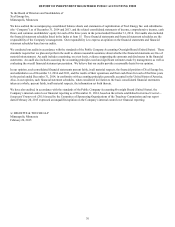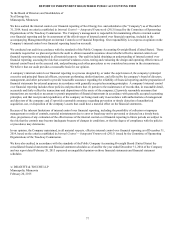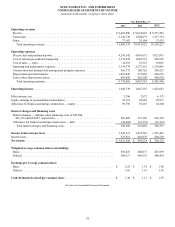Xcel Energy 2014 Annual Report Download - page 86
Download and view the complete annual report
Please find page 86 of the 2014 Xcel Energy annual report below. You can navigate through the pages in the report by either clicking on the pages listed below, or by using the keyword search tool below to find specific information within the annual report.
68
Determining the fair value of FTRs requires numerous management forecasts that vary in observability, including various forward
commodity prices, retail and wholesale demand, generation and resulting transmission system congestion. Given the limited
observability of management’s forecasts for several of these inputs, these instruments have been assigned a Level 3. Level 3
commodity derivatives assets and liabilities included $67.0 million and $10.9 million of estimated fair values, respectively, for FTRs
held at Dec. 31, 2014.
Determining the fair value of certain commodity forwards and options can require management to make use of subjective price and
volatility forecasts which extend to periods beyond those readily observable on active exchanges or quoted by brokers. When less
observable forward price and volatility forecasts are significant to determining the value of commodity forwards and options, these
instruments are assigned to Level 3. There were no Level 3 forwards or options held at Dec. 31, 2014.
Nuclear Decommissioning Fund — Nuclear decommissioning fund assets assigned to Level 3 consist of private equity investments
and real estate investments. Based on an evaluation of NSP-Minnesota’s ability to redeem private equity investments and real estate
investment funds measured at net asset value, estimated fair values for these investments totaling $165.5 million in the nuclear
decommissioning fund at Dec. 31, 2014 (approximately 9.2 percent of total assets measured at fair value) are assigned to Level 3.
Realized and unrealized gains and losses on nuclear decommissioning fund investments are deferred as a regulatory asset.
Liquidity and Capital Resources
Cash Flows
(Millions of Dollars) 2014 2013 2012
Net cash provided by operating activities . . . . . . . . . . . . . . . . . . . . . . . . . . . . . . . . . . . . $ 2,648 $ 2,584 $ 2,005
Net cash provided by operating activities increased by $64 million for 2014 as compared to 2013. Additional net income, excluding
amounts related to non-cash operating activities (e.g. depreciation and deferred tax expenses) and lower pension contributions in 2014
were offset by changes in working capital and other noncurrent assets and liabilities.
Net cash provided by operating activities increased by $579 million for 2013 as compared to 2012. The increase was primarily the
result of higher net income, changes in working capital due to the timing of payments and receipts, net changes in regulatory assets
and liabilities, and payments mainly related to interest rate swap settlements in 2012.
(Millions of Dollars) 2014 2013 2012
Net cash used in investing activities . . . . . . . . . . . . . . . . . . . . . . . . . . . . . . . . . . . . . . . . . $ (3,117) $ (3,213) $ (2,333)
Net cash used in investing activities decreased by $96 million for 2014 as compared to 2013. The decrease was primarily attributable
to higher capital expenditures in 2013 associated with several major construction projects including the Monticello nuclear EPU and
the PI steam generator replacement. The change in capital expenditures was partially offset by the impact of higher insurance
proceeds related to Sherco Unit 3 and proceeds received from the sale of certain transmission assets to Sharyland in 2013.
Net cash used in investing activities increased by $880 million for 2013 as compared to 2012. The increase was primarily the result of
higher capital expenditures for several major construction projects including the Monticello nuclear EPU project as well as the PI
steam generator replacement and certain other transmission line projects. Other differences mainly related to changes in restricted
cash.
(Millions of Dollars) 2014 2013 2012
Net cash provided by financing activities . . . . . . . . . . . . . . . . . . . . . . . . . . . . . . . . . . . . $ 442 $ 654 $ 350
Net cash provided by financing activities decreased by $212 million for 2014 as compared to 2013. The decrease was primarily due to
lower proceeds from long-term debt, less issuances of common stock and higher dividend payments, partially offset by higher
proceeds from short-term debt and lower repayments of long-term debt.
Net cash provided by financing activities increased by $654 million for 2013 as compared to 2012. The increase was primarily due to
the issuance of more common stock during 2013, lower repayments of previously existing long-term debt, which was partially offset
by reductions in long-term and short-term borrowing.
See discussion of trends, commitments and uncertainties with the potential for future impact on cash flow and liquidity under Capital
Sources.



